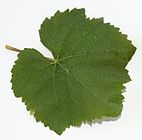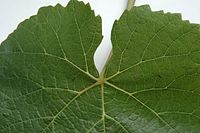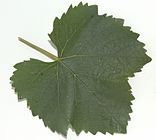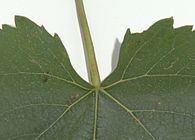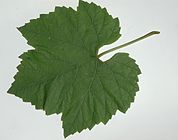White Burgundy
| Pinot blanc | |
|---|---|
| Synonyms | Weißer Burgunder, Weißburgunder, Pinot bianco, Klevner, - for more see section Synonyms |

|
|
| Art | Grape vine ( Vitis vinifera subsp. Vinifera ) |
| Berry color | yellow-green |
| use | |
| origin | France, Burgundy |
| known since | 14th century |
| VIVC no. | 9272 |
| ancestry | |
| List of grape varieties | |
The Pinot blanc , Pinot Blanc , Pinot Blanc , Pinot bianco or Klevner is a white wine . It has been known since the 14th century and is one of the Burgundy varieties .
Descent, origin
The area between Lake Geneva (Switzerland) and the Rhône Valley (France) is believed to be the home of the Pinot varieties. Pinot blanc was created by mutating Pinot Noir , which may have been around for 2,000 years. In the Swiss canton of Valais , Pinot Blanc is also considered a traditional grape variety.
The order of the Cistercians brought the Pinot Blanc to the Rheingau in the Middle Ages, from here it spread throughout Europe. In France, the variety was described in Burgundy in 1895, but by German ampelographers as early as the early 19th century.
Although the differences were recognized early on, the Pinot blanc and Chardonnay varieties were not kept apart in the vineyard because of the great similarity and were cultivated together until the middle of the last century. However, with the increasing importance of viticulture, there were important differences in the cultivation of the two varieties. In Burgundy, the Chardonnay variety was preferred because it ripened somewhat earlier and was less susceptible to botrytis . Today it has practically disappeared in the area of origin of the White Burgundy.
The French term "Pinot" is probably derived from the elongated shape of the Pinot grapes, which are quite similar to the cones of a pine (French "pin"). The term "Burgunder", which is common in German-speaking countries, is not a translation of the French name, but a designation of the area.
Ampelographic varietal characteristics
For a long time, no distinction was made between Pinot Blanc, Chardonnay and Auxerrois , as all three varieties are very similar. Here is an overview of the most important ampelographic features.
Leaf - Pinot Blanc
Grapes - Pinot Blanc
- The shoot tip is open. It is very hairy whitish light green.
- The shoots are medium strong with dense foliage.
- The young leaves are initially hairy cobwebs to be almost hairless later.
- The medium-sized, dark-green leaves are approximately equilateral pentagon in shape, usually wholly or slightly three-lobed, but rarely five-lobed, although slightly indicated. The peduncle is open in a V-shape and the peduncle vein is lapped. The blade is bluntly serrated. The teeth are medium-sized compared to the grape varieties. The leaf surface is blistered and coarse.
- The cylindrical grape is rarely shouldered, medium-sized, dense and has small to medium-sized, greenish-yellow colored berries with a thin skin. The berries can reach a high sugar content and the pulp is juicy and has a subtle fruity note.
The White Burgundy can only be clearly distinguished from the Blue Burgundy and Ruländer from the beginning of the ripening phase (color change of the berries) .
Maturity: medium late
properties
There are few problems growing Pinot Blanc in the vineyard. However, it is not suitable for soils that are too light and dry. In good locations and with good ripeness, the variety delivers high quality wines with a good shelf life. The dense berry grapes can be thinned out well with gibberellic acid (GA3), a phytohormone. This prevents botrytis infestation.
The disadvantage of the variety is the medium resistance to winter frost, that it places high demands on the location and that a high must weight is required for good wine quality. White Burgundy is susceptible to chlorosis and botrytis and is increasingly attacked by grape moth.
Demands on soil and location
The variety needs good soils with sufficient water storage capacity and a higher lime content. Medium-heavy soils and warm locations are necessary for good wine quality. On sandy and rocky soils, the wine only reaches a small amount of extract - thin wines. Damp and low-lime soils are unsuitable - wines acquire an atypical taste.
Yield
medium high, regular
distribution
The White Burgundy is grown in many European countries, especially Germany, Italy, Austria and France. Because of the great similarity with the Chardonnay variety , in some countries no distinction was made between Chardonnay and Pinot Blanc when recording the area of the vineyards, so that statistical figures were unreliable until the 1980s. In Italy, for example, serious surveys were not started until 1978 to determine the proportion of Chardonnay in the vineyards or to separate it from Pinot Bianco . Therefore, the Chardonnay does not appear in Italian statistics until the early 1980s. In Austria, both varieties were recorded in total up to the 1999 vineyard survey. In Germany, Chardonnay was only approved for cultivation by the Bundessortenamt in 1994 .
Worldwide cultivation areas of the white Burgundy grape variety. It ranks 52nd in the 2010 global grape variety area ranking.
| country | Vineyards ha |
|---|---|
| Argentina | 6th |
| Brazil | 1 |
| Chile | 10 |
| China | 2 |
| Germany | 3941 |
| France | 1280 |
| Georgia | 219 |
| Italy | 3086 |
| Canada | 125 |
| Croatia | 188 |
| Luxembourg | 162 |
| Moldova | 350 |
| New Zealand | 16 |
| Austria | 1914 |
| Portugal | 22nd |
| Russia | 695 |
| Switzerland | 105 |
| Slovakia | 523 |
| Slovenia | 525 |
| South Africa | 14th |
| Czech Republic | 732 |
| Ukraine | 338 |
| Hungary | 237 |
| United Kingdom | 23 |
| Uruguay | 9 |
| United States | 269 |
| World acreage 2010 | 14792 |
Germany
In Germany , the variety is mainly cultivated in Baden , the Palatinate , Rheinhessen and the Saxon Wine Route . In 2018 there was a total of 5,334 hectares of white Burgundy in Germany. This means that Germany has the most extensive Pinot Blanc vineyards in the world.
| Growing area | Area [ha] |
| Germany | 4,794 |
| Baden-Württemberg | 1,535 |
|
117 |
|
1,418 |
| Bavaria | 157 |
|
155 |
| Hesse | 69 |
|
22nd |
|
48 |
| Rhineland-Palatinate | 2,856 |
|
15th |
|
16 |
|
298 |
|
270 |
|
1,134 |
|
1,122 |
| New federal states | 162 |
|
103 |
|
59 |
Austria
In 2015 Austria had a cultivation area of 1916 ha. The grape variety is represented in all of Austria's wine-growing regions.
Wine

The wine is very rich with a piquant acidity reminiscent of apples and has a distinctive varietal character, but is rather neutral in the overall impression. The wine develops slowly and reaches its highest quality as old wine. Matured wines taste like fresh bread. Because of the high sugar content of its grapes, the variety is often used for the production of predicate wines.
In more southerly growing areas, the variety often lacks acidity , which is why it has been replaced by Chardonnay.
See also the articles Viticulture in Germany , Viticulture in France , Viticulture in Italy , Viticulture in Austria and Viticulture in Switzerland .
Synonyms
99 synonyms: Ag Pino, Arbst Weiss, Arnaison Blanc, Arnoison, Auvernas, Auvernat, Auvernat Blanc, Auxerrois, Beli Pinot, Beyaz Burgunder, Biela Klevanjka, Bijeli Pino, Blanc De Champagne, Bon Blanc, Borgogna Bianca, Borgogna Bianco, Borgognino, Borgona Blanco, Borgonja Bela Mala, Boronja Malo Zrno, Burgunda, Burgundac, Burgundac Beli, Burgundac Bijeli, Burgunder Blanc, Burgundy Weiss, Burgunder Weisser, Burgundi Feher, Burgundi Kisfeher, Burgundian Ximenestraub, Burgundske Bieli, Burgundske Bile, Chardonevner , Clevner, Down, Epinette, Epinette Blanche, Feher Burgundi, Feher Kisburgundi, Feher Klevner, Feherburgundi, Fin Plant Dore, Gentil Blanc, Grossburgunder, Kisburgundi Feher, Klaevner, Klaevner Weisser, Kleinedel, Kleinedel Weisser, Kleiner Weiss, Klevanjvner Bijela , Klevner Weiss, Moreote Variete Blanche, Morillon Blanc, Noirien Blanc, Pineau, Pineau Blanc, Pineau Blanc Vrai, Pino Belii, Pino Belyi, Pino Blan, Pino Na Vino, Pinot Bianco, Pinot Bianco Verde, Pinot Bijeli, Pinot Blanc Chardonnet, Pinot Blanc D'alsace, Pinot Blanc Vrai, Pinot Branco, Pinot Doux, Pinot Verde, Plant De La Dole, Plant Dore, Rehfall, Roci Bile, Rouci Bile, Rulaender Weiss, Rulandske Biele, Rulandske Bile, Rulandsky Bile, Spaetburger Dore, Spaeter Weisser Burgunder, Vejser Burgunder, Vert Plant, Weiss Elder, Weissarbst, Weissburgunder, Weissclaeven, Weissclevener, Weisser Arbst, Weisser Burgunder, Weisser Klaevner, Weisser Klevner, Weissergelber Klevner, Weissklaevler, Ximengelberesiavner Burgundica.
literature
- Karl Bauer, Ferdinand Regner , Barbara Schildberger: Weinbau , avBuch im Cadmos Verlag, Vienna, 9th edition 2013, ISBN 978-3-7040-2284-4 .
- Jancis Robinson , Julia Harding, José Vouillamoz : Wine Grapes , 1st edition 2012, Penguin Books, London, ISBN 978-0-06-220636-7 (English).
- Cornelius Lange, Fabian Lange, Horst Dippel : The Wine Lexicon . Fischer Taschenbuch 15867, Frankfurt am Main 2003, ISBN 3-596-15867-2 .
- Jancis Robinson : The Oxford Wine Lexicon . 3. Edition. Hallwag , Munich 2007, ISBN 978-3-8338-0691-9 .
- Dagmar Ehrlich , Stefan Braun (photos): The ABC of grape varieties . Vines and their wines. 1st edition. Hallwag , Munich 2005, ISBN 3-7742-6960-2 .
- Pierre Galet : Dictionnaire encyclopédique des cépages . 1st edition. Hachette Livre, Paris 2000, ISBN 2-01-236331-8 (French).
- Walter Hillebrand, Heinz Lott, Franz Pfaff: Paperback of the grape varieties . 13th edition. Fachverlag Fraund, Mainz 2003, ISBN 3-921156-53-X .
- Hans Ambrosi , Bernd HE Hill, Erika Maul, Erst H. Rühl, Joachim Schmid, Fritz Schuhmann: Color atlas grape varieties 3rd edition, Eugen Ulmer, 2011, ISBN 978-3-8001-5957-4 .
Web links
- Variety description of Pinot Blanc , Geisenheim University, Institute for Vine Breeding (PDF)
Individual evidence
- ↑ Article 32 Traditional grape varieties of the (PDF) Ordinance on Viticulture and Wine (VRW, 916.142) , Sion March 17, 2004
- ↑ K. Anderson, NR Aryal: Database of Regional, National and Global Winegrape Bearing Areas by Variety, 2000 and 2010, Wine Economics Research Center, University of Adelaide, December 2013 (first revision April 2014) (second revision May 2014) (third Revision July 2014).
- ↑ German Wine Institute : Statistics 2019/2020 . Bodenheim 2019 ( deutscheweine.de [PDF; 706 kB ] Planted vineyards and important grape varieties by growing area in 2018).
- ↑ Cultivation statistics for 2014 Federal Statistical Office (2015): Agriculture and Forestry, Fisheries. Agricultural land use - vineyards. Technical series 3 series 3.1.5.
- ↑ Weingarten Basics Survey 2015, Statistics Austria, quick report 1.19
- ↑ Weißer Burgunder in the database Vitis International Variety Catalog of the Institute for Vine Breeding Geilweilerhof (English), accessed on February 25, 2020
